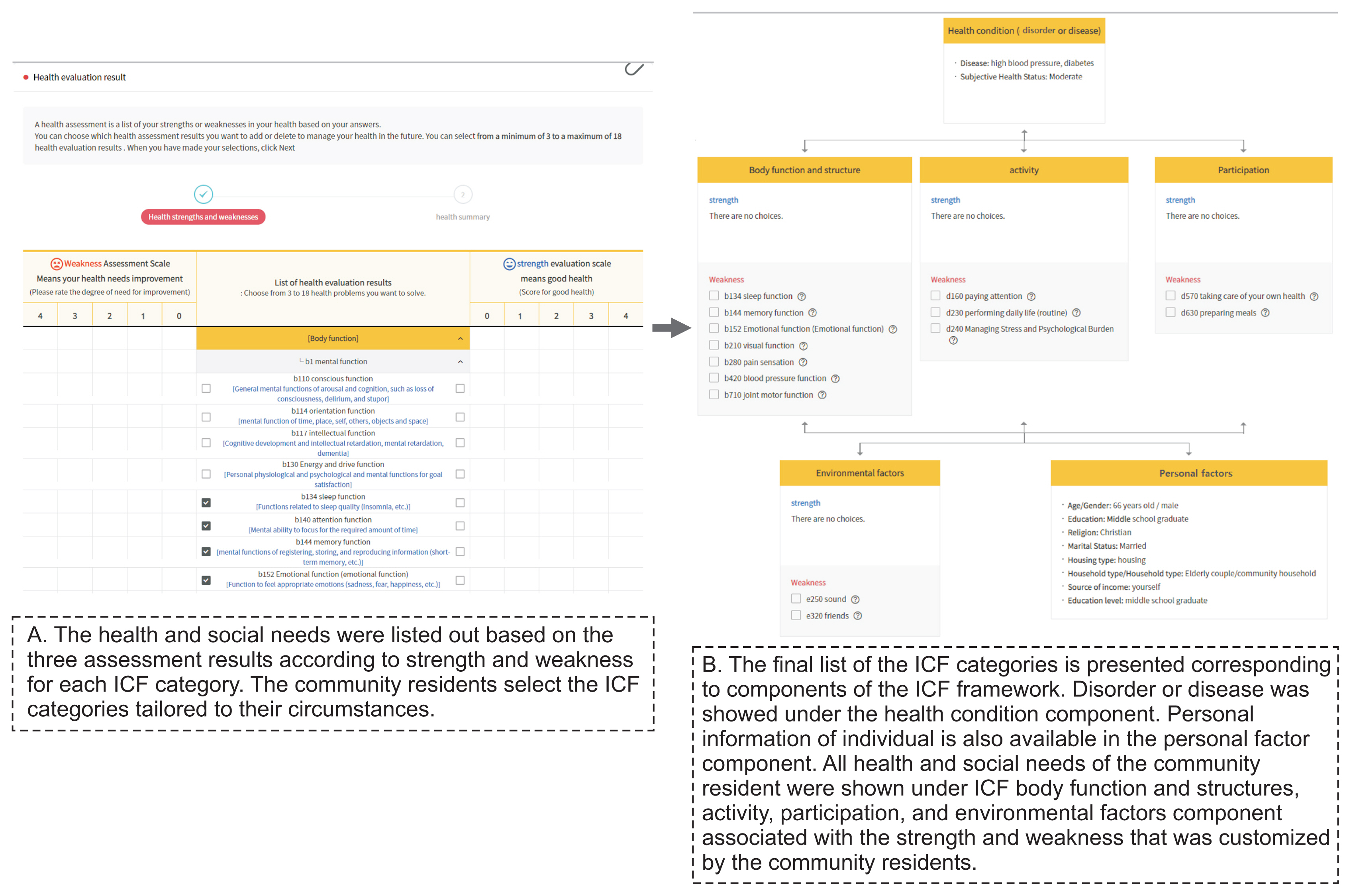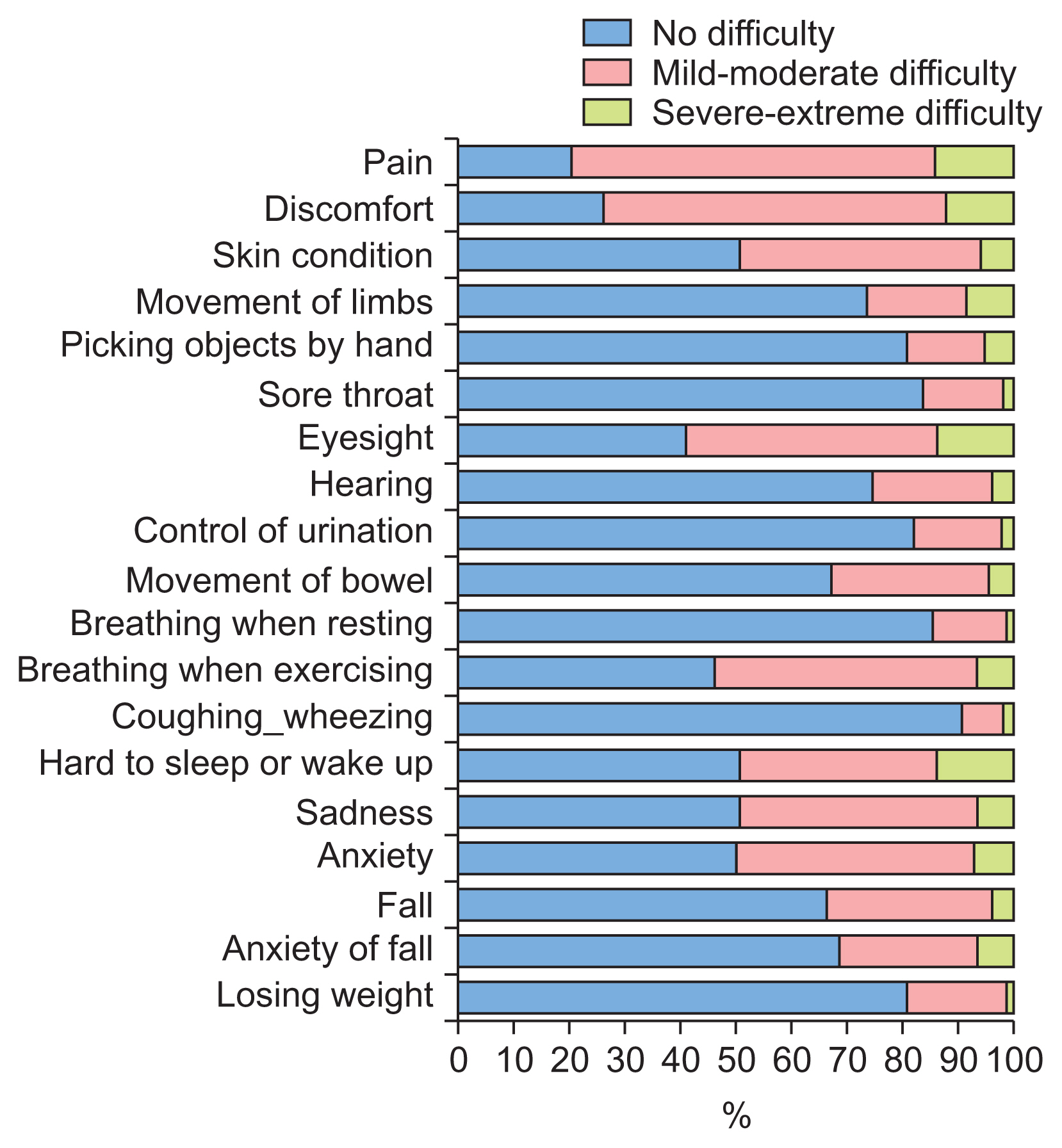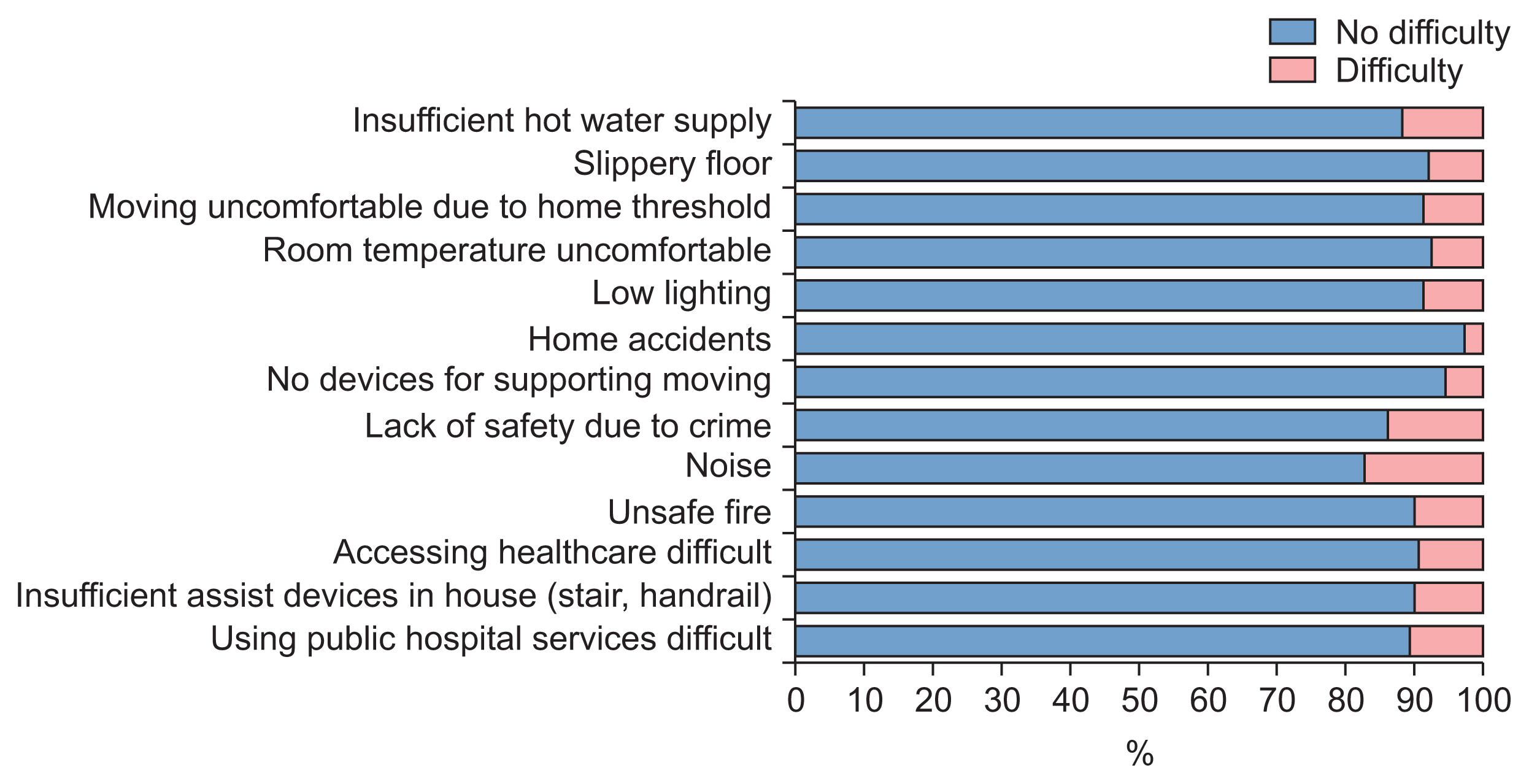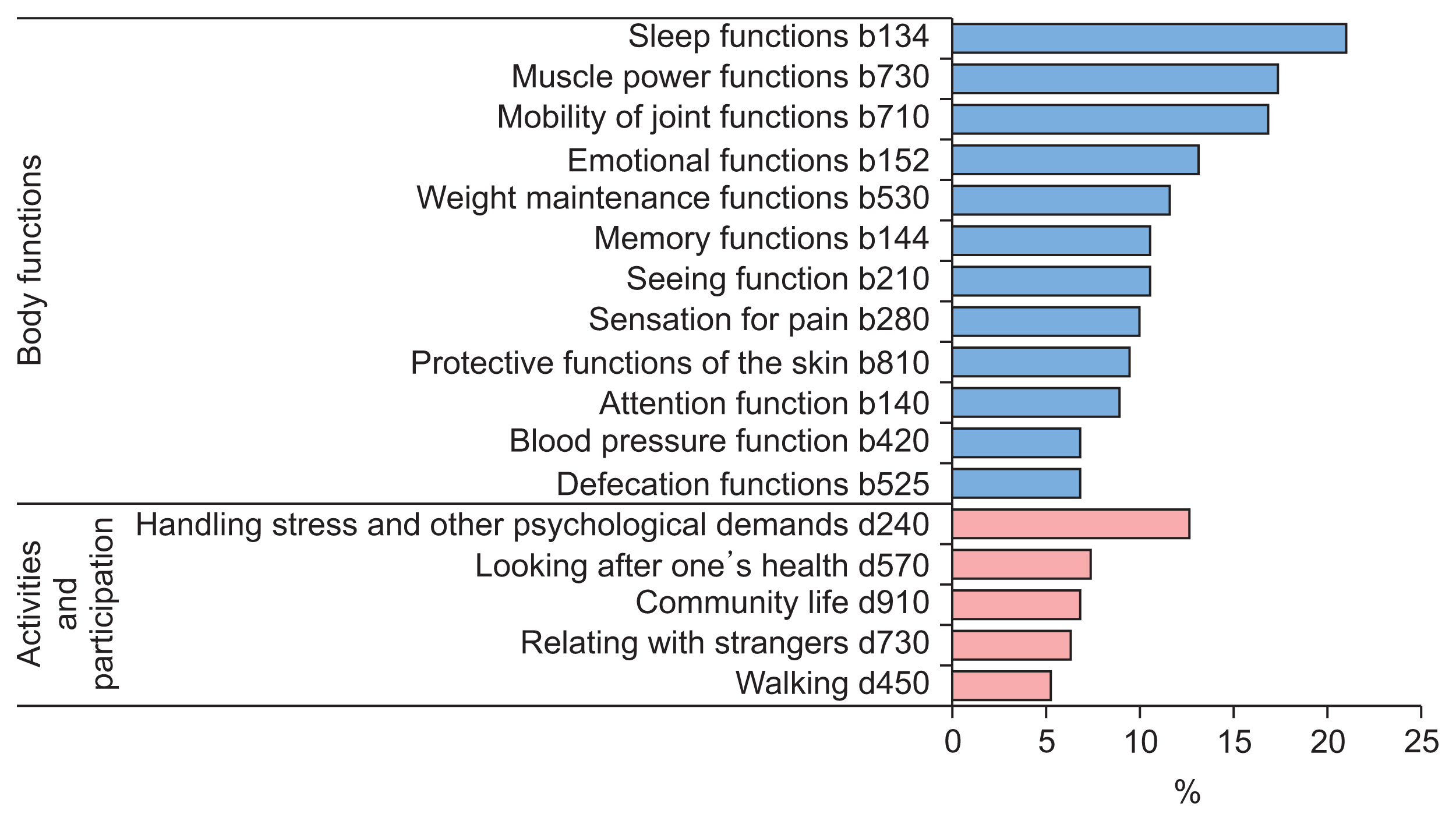Healthc Inform Res.
2022 Jul;28(3):198-209. 10.4258/hir.2022.28.3.198.
Exploring the Health and Social Needs of Community Residents Using an Online Community Care Platform: Linkage to the International Classification of Functioning, Disability, and Health
- Affiliations
-
- 1College of Nursing, Chungnam National University, Daejeon, Korea
- 2Mindlle Health Welfare Social Cooperation, Daejeon, Korea
- KMID: 2532447
- DOI: http://doi.org/10.4258/hir.2022.28.3.198
Abstract
Objectives
This study aimed to analyze the outcomes of the Comprehensive Health and Social Need Assessment (CHSNA) system, which identifies community residents’ health and social needs, and to link these needs with the International Classification of Functioning, Disability, and Health (ICF).
Methods
Adult community residents in a metropolitan city in Korea were recruited. They were asked to assess their health and social needs via the CHSNA system, which was integrated into an online community-care platform. Three assessment steps (basic health assessment, needs for activities of daily living, and in-depth health assessment) associated with five ICF components were used to evaluate physical health impairment, difficulties in activities and participation, and environmental problems. The final list of health and social needs was systematically linked to the domains and categories of the ICF. Only data from participants who completed all three assessment steps were included.
Results
Wide ranges of impairments and difficulties regarding the daily living activities, physical health, and environmental status of the community were recorded from 190 people who completed assessments of their health and social needs by the CHSNA system. These participants reported various health and social needs for their community life; common needs corresponded to the ICF components of body functions and activities/participation.
Conclusions
The ICF may be suitable for determining the health-related problems and needs of the general population. Possible improvements to the present system include providing support for completing all assessment steps and developing an ICF core set for an enhanced understanding of health and social needs.
Keyword
Figure
Reference
-
References
1. World Health Organization. WHO global strategy on people-centred and integrated health services: interim report. Geneva, Switzerland: World Health Organization;2015.2. Baxter S, Johnson M, Chambers D, Sutton A, Goyder E, Booth A. The effects of integrated care: a systematic review of UK and international evidence. BMC Health Serv Res. 2018; 18(1):350. https://doi.org/10.1186/s12913-018-3161-3.
Article3. Alderwick H, Ham C, Buck D. Population health systems: going beyond integrated care (The King’s Fund Report). Boston (MA): Policy Commons;2015.4. Ministry of Health and Welfare. Implementation of social services (community care) based on the community [Internet]. Sejong, Korea: Ministry of Health and Welfare;2018. [cited at 2022 Jun 30]. Available from: http://www.mohw.go.kr/react/al/sal0301vw.jsp?PAR_MENU_ID=04&MENU_ID=0403&CONT_SEQ=344177&page=1.5. World Health Organization. Strengthening people-centered health systems in the WHO European Region: framework for action on integrated health services delivery. Geneva, Switzerland: World Health Organization;2016.6. Han KT, Park EC, Kim SJ. Unmet healthcare needs and community health center utilization among the low-income population based on a nationwide community health survey. Health Policy. 2016; 120(6):630–7. https://doi.org/10.1016/j.healthpol.2016.04.004.
Article7. Kim YS, Lee J, Moon Y, et al. Unmet healthcare needs of elderly people in Korea. BMC Geriatr. 2018; 18(1):98. https://doi.org/10.1186/s12877-018-0786-3.
Article8. Jung B, Ha IH. Determining the reasons for unmet healthcare needs in South Korea: a secondary data analysis. Health Qual Life Outcomes. 2021; 19(1):99. https://doi.org/10.1186/s12955-021-01737-5.
Article9. Harrison F, Low LF, Barnett A, Gresham M, Brodaty H. What do clients expect of community care and what are their needs? The Community care for the Elderly: Needs and Service Use Study (CENSUS). Australas J Ageing. 2014; 33(3):206–13. https://doi.org/10.1111/ajag.12118.
Article10. Ustun TB, Kostanjsek N, Chatterji S, Rehm J. Measuring health and disability: manual for WHO disability assessment schedule (WHODAS 20). Geneva, Switzerland: World Health Organization;2010.11. Philip KE, Alizad V, Oates A, Donkin DB, Pitsillides C, Syddall SP, et al. Development of EASY-Care, for brief standardized assessment of the health and care needs of older people; with latest information about cross-national acceptability. J Am Med Dir Assoc. 2014; 15(1):42–6. https://doi.org/10.1016/j.jamda.2013.09.007.
Article12. Reynolds T, Thornicroft G, Abas M, Woods B, Hoe J, Leese M, et al. Camberwell Assessment of Need for the Elderly (CANE): development, validity and reliability. Br J Psychiatry. 2000; 176:444–52. https://doi.org/10.1192/bjp.176.5.444.
Article13. Alford VM, Ewen S, Webb GR, McGinley J, Brookes A, Remedios LJ. The use of the International Classification of Functioning, Disability and Health to understand the health and functioning experiences of people with chronic conditions from the person perspective: a systematic review. Disabil Rehabil. 2015; 37(8):655–66. https://doi.org/10.3109/09638288.2014.935875.
Article14. World Health Organization. International Classification of Functioning, Disability and Health. Geneva, Switzerland: World Health Organization;2001. [cited at 2022 Jun 30]. Available from: https://www.who.int/standards/classifications/international-classification-of-functioning-disability-and-health.15. Jelsma J. Use of the International Classification of Functioning, Disability and Health: a literature survey. J Rehabil Med. 2009; 41(1):1–12. https://doi.org/10.2340/16501977-0300.
Article16. Dernek B, Esmaeilzadeh S, Oral A. The utility of the International Classification of Functioning, Disability and Health checklist for evaluating disability in a community-dwelling geriatric population sample. Int J Rehabil Res. 2015; 38(2):144–55. https://doi.org/10.1097/MRR.0000000000000101.
Article17. Jayakumar P, Overbeek CL, Lamb S, Williams M, Funes CJ, Gwilym S, et al. What factors are associated with disability after upper extremity injuries? A systematic review. Clin Orthop Relat Res. 2018; 476(11):2190–215. https://doi.org/10.1097/CORR.0000000000000427.
Article18. Cerniauskaite M, Quintas R, Boldt C, Raggi A, Cieza A, Bickenbach JE, et al. Systematic literature review on ICF from 2001 to 2009: its use, implementation and operationalisation. Disabil Rehabil. 2011; 33(4):281–309. https://doi.org/10.3109/09638288.2010.529235.
Article19. Howard D, Nieuwenhuijsen ER, Saleeby P. Health promotion and education: application of the ICF in the US and Canada using an ecological perspective. Disabil Rehabil. 2008; 30(12–13):942–54. https://doi.org/10.1080/09638280701800483.
Article20. Park M, Bui LK, Jeong M, Choi EJ, Lee N, Kwak M, et al. ICT-based person-centered community care platform (IPC3P) to enhance shared decision-making for integrated health and social care services. Int J Med Inform. 2021; 156:104590. https://doi.org/10.1016/j.ijmedinf.2021.104590.
Article21. Park M, Choi EJ, Jeong M, Lee N, Kwak M, Lee M, et al. ICT-based comprehensive health and social-needs assessment system for supporting person-centered community care. Healthc Inform Res. 2019; 25(4):338–43. https://doi.org/10.4258/hir.2019.25.4.338.
Article22. Ministry of Culture Sports and Tourism. National Leisure Activity Survey 2018 [Internet]. Sejong, Korea: Ministry of Culture Sports and Tourism;2019. [cited at 2022 Jun 30]. Available from: https://www.mcst.go.kr/kor/s_notice/press/pressView.jsp?pSeq=17085.23. Ustun TB, Chatterji S, Villanueva M, Bendib L, Celik C, Sadana R, et al. WHO multi-country survey study on health and responsiveness 2000–2001. Geneva, Switzerland: World Health Organization;2001.24. Korean Disease Control and Prevention Agency. Community Health Survey 2016 [Internet]. Cheongju, Korea: Disease Control and Prevention Agency;2017. [cited at 2022 Jun 30]. Available from: https://chs.kdca.go.kr/chs/recsRoom/healthStatsMain.do.25. Lee M, Heo HH. Investigating similarities and differences in health needs according to disability type using the International Classification of Functioning, Disability and Health. Disabil Rehabil. 2021; 43(26):3723–32. https://doi.org/10.1080/09638288.2020.1773941.26. Rast FM, Labruyere R. ICF mobility and self-care goals of children in inpatient rehabilitation. Dev Med Child Neurol. 2020; 62(4):483–8. https://doi.org/10.1111/dmcn.14471.27. Flitcroft L, Chen WS, Meyer D. The demographic representativeness and health outcomes of digital health station users: longitudinal study. J Med Internet Res. 2020; 22(6):e14977. https://doi.org/10.2196/14977.
Article28. Bol N, Helberger N, Weert JC. Differences in mobile health app use: a source of new digital inequalities? Inf Soc. 2018; 34(3):183–93. https://doi.org/10.1080/01972243.2018.1438550.
Article29. Fischer SH, David D, Crotty BH, Dierks M, Safran C. Acceptance and use of health information technology by community-dwelling elders. Int J Med Inform. 2014; 83(9):624–35. https://doi.org/10.1016/j.ijmedinf.2014.06.005.
Article30. Mbanda N, Dada S, Bastable K, Ingalill GB, Ralf WS. A scoping review of the use of visual aids in health education materials for persons with low-literacy levels. Patient Educ Couns. 2021; 104(5):998–1017. https://doi.org/10.1016/j.pec.2020.11.034.
Article
- Full Text Links
- Actions
-
Cited
- CITED
-
- Close
- Share
- Similar articles
-
- The role and responsibility of community health practitioner based on the rural community development and the reform of health care system
- ICT-Based Comprehensive Health and Social-Needs Assessment System for Supporting Person-Centered Community Care
- Impact and Application of the Internal Classification Functioning, Disability and Health in the Medical Rehabilitation
- Tasks to Establish the Role of Hospice and Palliative Care Social Workers in Community Care
- Disability epidemiology and health policy in Korea










